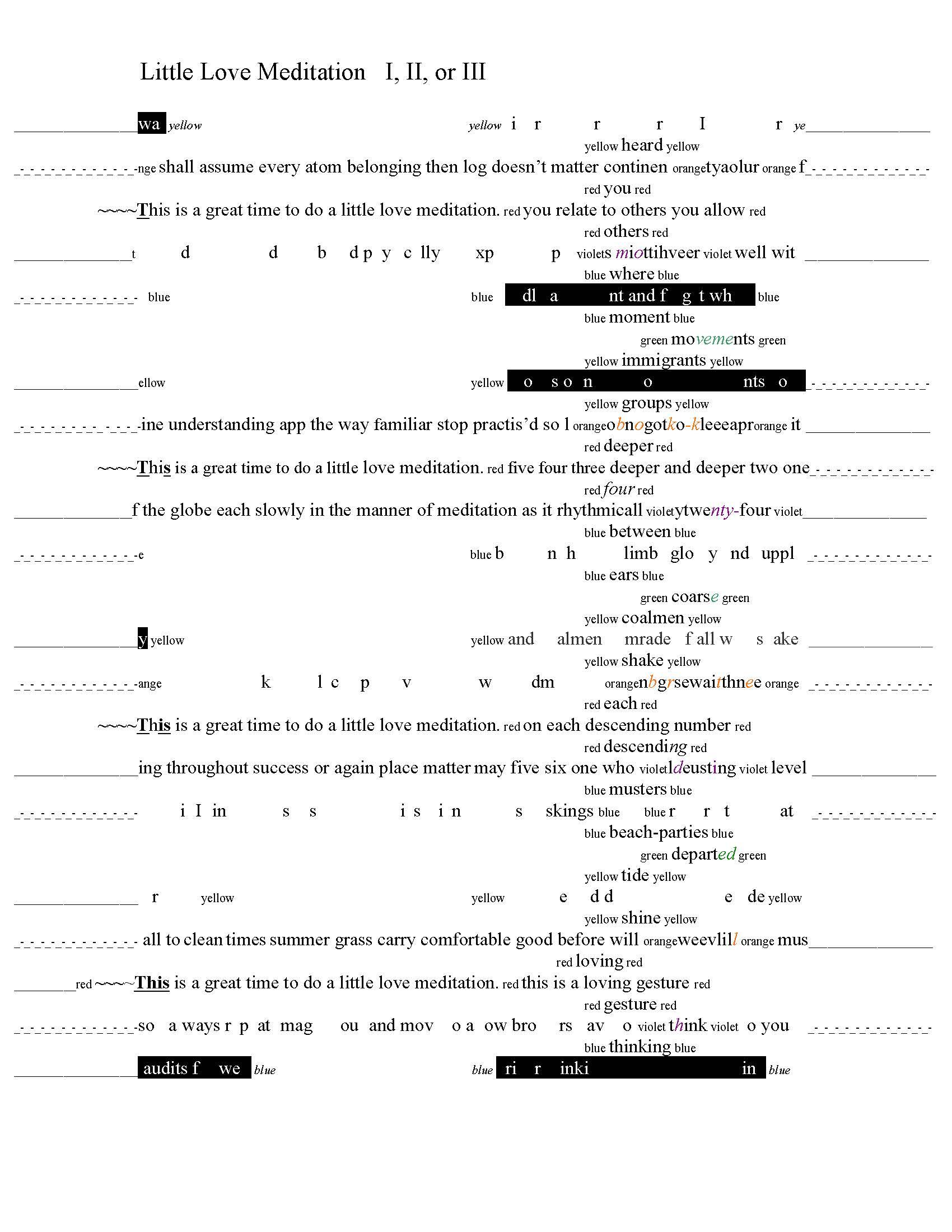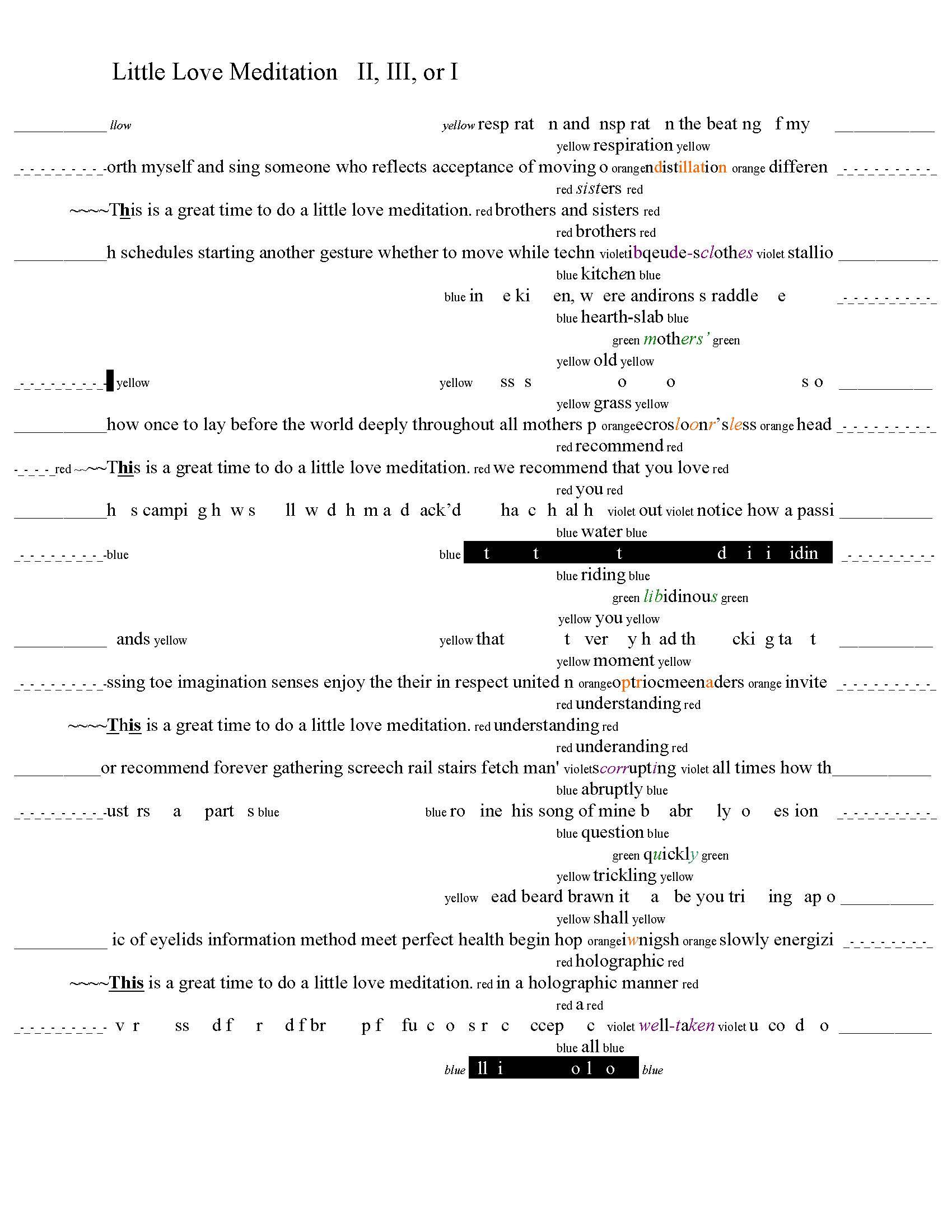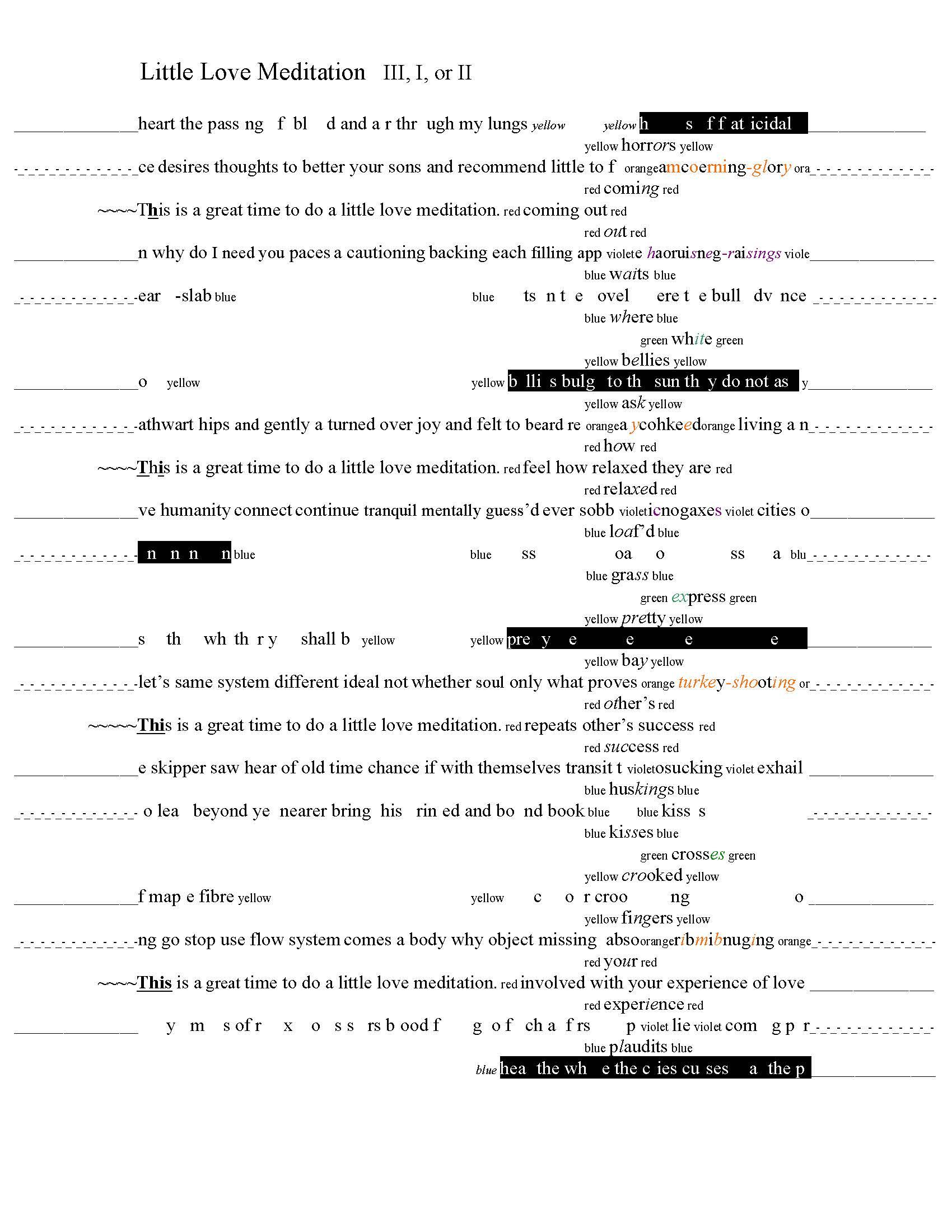A Little Love Meditation undermines the idea of the poem as a fixed language object, thus significantly altering its role in both silent reading and spoken performance. Each reader/performer plays an essential role in authoring the score’s content, the conceptual order of its elements and its derivative meaning; with coaxing coherence from the text by supplying each element with some sense of order and a resulting semantic value. A Little Love Meditation is a complex mechanism that provides a framework and the potential for the production of meaning. The order given to the poem’s elements occurs differently from one reading to the next, therefore so is the meaning resulting from each performance entirely unique. The seemingly intraversable configurations belonging to the score may be negotiated by myriad means in countless ways, but by every route one may likely become stifled by every attempt to reconcile the disjunction that is prevalent in the score. As Jennifer Scappitone notes of Jackson Mac Low’s work in her essay ‘Più mOndo i: / tUtti!,’ “what bits [of text] appear parsable in these lines call out to be read as two-way traffic, so that a reader, perhaps stupefied by efforts to gloss … might work backward to recover the disjointed [textual fragments] before moving on to test [others] ... Fragments are mobilized and worn, buoyed up and swallowed here as by the shore,” (186). It evokes an act of reading performance, a sort of textual interpretation that departs, inevitably, from conventional patterns of reading, and entails a uniquely rigorous application of all conscious faculties to textual and audible features of the score. The score serves, in this sense, as a readied system whose contents will change at each instance that they are acted upon. The production of meaning occurs through a negotiation of the material properties of sounded language between author and reader/listener within the act of reading performance. The score thus demonstrates the idea that the text itself is not a fixed object, nor is the act of performance an act secondary to the text; the two are instead necessary stages within a larger process, in which both the act of reading and sounding the poem’s content play an equally important role in the production of meaning determined during the moment of performance.
A Little Love Meditation is not fully realized until the moment of performance, thus the language objects appearing in the love score occur on a continuum that intersects with the author and performer and an ever-expanding audience. Through the continuity of the score runs a current created by meaning and non-meaning oscillating within the performer and throughout the performance space. Each phoneme of the score shares the same emptiness, until it is impregnated by way of free association or some other interpretive process of one’s choosing—where the music of language is activated and disseminated by way of interaction, in a dance between the poet, performer, the audience, and the text itself. As John Cage says of Feldman’s music, “It is nothing that goes on and on without beginning or middle or meaning or ending. Something is always starting and stopping, rising and falling.” What is the body that partakes in this dance; what is its form in motion, and while at rest? It is comprehensible and incomprehensible; it is structured where there is diversification, and it is formless where content is homogenously meaningless.
I chose Walt Whitman’s “Song of Myself” as a source text because of its beautiful incantations of love, and because the poem seems to represent the form of the body as it occurs along a similar continuum in the same strange elliptical space. Whitman’s use of metaphor in reference to the body renders the body both literally incomprehensible, and ironically understood. He says, “My ties and ballasts leave me, my elbows rest in seagaps./ I skirt sierras, my palms cover continents,/ I am afoot with my vision,” (“Song of Myself” 57). In a literal sense, the logic presented by these lines is baffling, because the various parts of the body are not the same as, nor are they of the same scope as the terrestrial objects they are coupled with. Yet metaphorically these objects become less estranged, and disparate objects become united in a similarity that can only be recognized through familiarity. For the strange to become familiar we must suspend our belief in the logical and enter into the elliptical space of the metaphor, where the object refers always both to and from itself, and the reader is thrust like a boomerang into a dance with the text and the liminal mind.
A Little Love Meditation redistributes the language of two textual bodies (“Song of Myself” and a love meditation produced by the Sylva Corporation) in indeterminate patterns. In A Little Love Meditation, “lyrical traffic” is directed through an unbending network of channels, where colored lines that, like subway schedule markings, route lingual traffic throughout the score, distinguish certain routing categories. Performers decide the paths taken spontaneously, in response to the conditions in which the score is encountered. The score is constructed around twelve line complexes: every line complex is comprised of two continual lines which run parallel to and on either side of one “red” mainline. Stemming from each mainline are two feeds which combine with two mergers. Through each merger runs one continual line from which extends a series of subsidiary lines. Each line of the score continues as far as is required by the number of graphemes and spaces contributing to its particular length, until it reaches the right margin of the page, where lines may spill over onto the next page. In this way, the physical properties pertaining to the borders and text of each page serve to govern the placement of text within the field of a particular page, but do not inhibit the semantic possibilities conceivable within the total score. Similarly, the textual construct of the total score helps to promote a broader continuum in which the total score and each of its source texts are situated. Each instance of overlapping text and merging of meanings promotes the occurrence of this continuum, which appears most visibly where the spatial properties and lingual values upset syntactic borders as well as those of the page.
The rules of the score are as follows: The reader must begin at a mainline and read until they reach the two merger points. From there they may read up or down until they find a new line of their choosing. Readers are encouraged to traverse as many different lines as possible, as long as every line traversed is reached vertically by way of line mergers.
Random numbers are generated using the Microsoft Excel Random number Generator, the same program used to determine probable consequences of deploying an atomic bomb. Using these numbers, syllables are selected from the ‘syllable pool’ of a given narrative unit to form clusters that, in some instances, may form words in any language. In some instances single syllables will remain alone. It all depends on the numbers selected. The random number generator will determine the number of syllables in each cluster, as well as the number of clusters to appear in the score.
The procedure generates words from syllables according to language value (semantic potential). Left now to envision is the phonetic value of each syllable.


